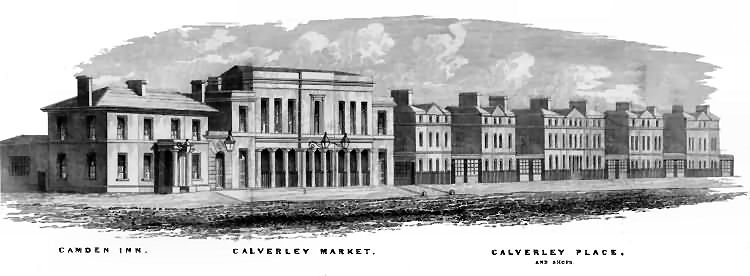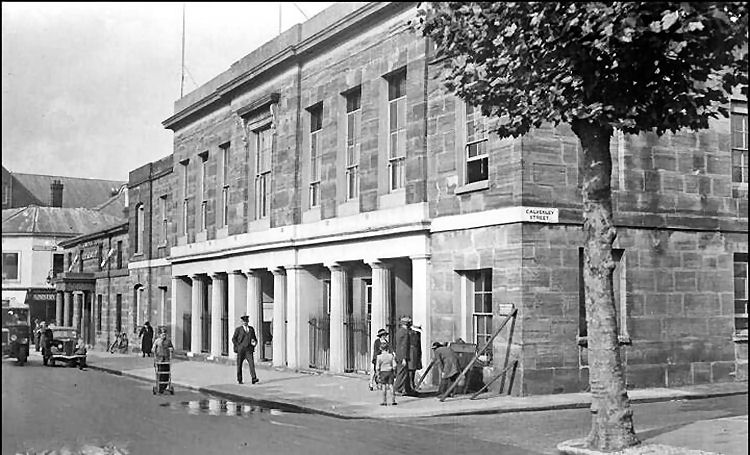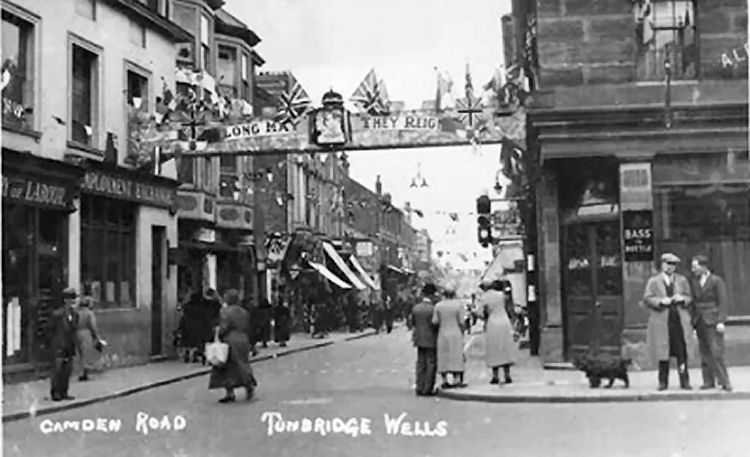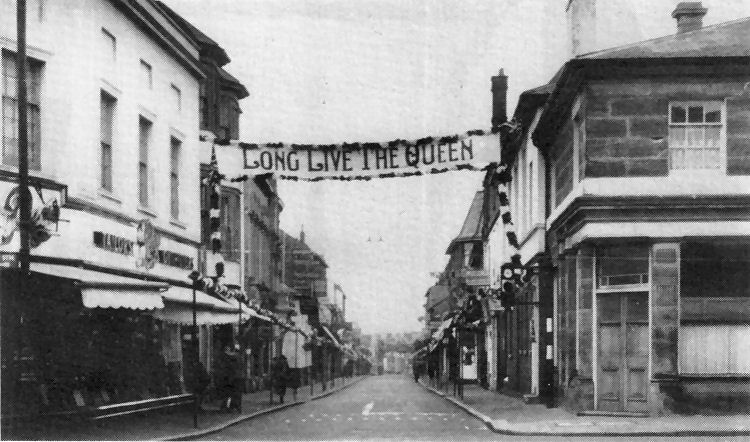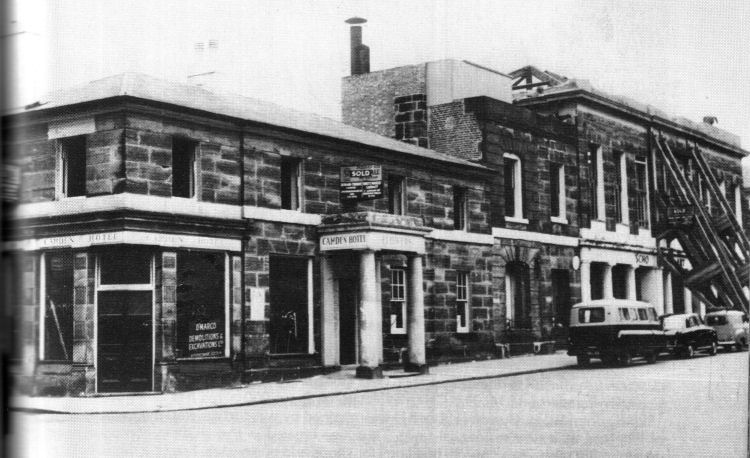|
THE HISTORY OF THE CAMDEN INN-CALVERLEY ROAD
Written By; Edward James Gilbert:-Thunder Bay, Ontario, Canada
Date: May 13, 2014
OVERVIEW
The "Camden Hotel," referred to in early records as the "Camden Inn," was
built between 1824 and 1829, and was initially owned by John Ward, the
man behind the development of the Calverley Estate. The “Descriptive
Sketches of Tunbridge Wells and The Calverley Estate' by John Britton
(1832) states “ A new hotel (the Camden) has lately been built”. John
Ward engaged Decimus Burton (1800-1881) to prepared plans for his
development with Burton designing many of the buildings constructed in
it, including the "Camden Inn," the Calverley Market constructed in 1835
next door to the "Camden Inn" as well as the residences in Calverley Place
next to the Calverley Market. The "Camden Inn" as well as the other
buildings were all built of local sandstone and of a similar
architectural style. Shown opposite is an image of the
"Camden Inn" and the
other buildings referred to, from Peltons 1840 Guide.
The "Camden Inn/Hotel" was not among the class of prominent hotels in the
town for although referred to as a “hotel” in many records it is better
described as being an “Inn”, a typical English public house, on the main
floor of which was a large tavern area fitted out with a bar and tables
and chairs with a nice large fireplace to keep the patrons warm on
miserable days. At the back of the tavern area would have been a kitchen
and storage and in the basement would be found the barrels of ale. The
upper floor of the Inn provided the living quarters for the proprietor
of the inn and his family and probably no more than five small rooms for
guests. The two rear extensions of the 2 storey building were single storey.
It is not known if these two wings were constructed at the time the inn
was built but they appear on maps from the 1830's and so certainly are
early parts of the overall building. Behind the inn was stabling to
house the horses and wagons of the inns clients and the proprietor.
The "Camden Inn" has seen many proprietors over the years, details of
which are given later. Between 1824 and 1959 there had been at least
twelve inn keepers. In 1959 the "Camden Inn" as well as adjacent buildings
within the entire block bordered by Camden Road, Calverley Street,
Calverley Road and Garden Street were all demolished to make way for a
large shop and office complex.
MAPS OF THE AREA
[insert George Charles Pratt 2nd Marquess Camden]
John Bowra's map of 1738 shows no buildings at all on Calverley Road.
The exact date of construction of the Camden Inn is not known by the
researcher but John Ward with Decimus Burton were most active in
developing the Calverley Estate lands in the 1820's particularly in the
period of 1823 to 1829. Details of Wards activities can be found in the
Civic Society book ‘The Residential Parks of Tunbridge Wells, although
no specific mention is made of the Camden Inn. The name of the Inn is
derived from George Charles Pratt, the 2nd Marquess of Camden
(1799-1866) who was possessed of large estates in Kent and other
places., and it was Lord Camden who was responsible for the creation of
Camden Park in the 1840's. A photo of Lord Camden is shown opposite.
[insert 1831 map from T.Wells 1951]
Shown opposite is a map from 1831 from the booklet ‘Tunbridge Wells
1951'. With respect to Ward's Calverley development the map shows four
buildings and the entrance gates to Calverley Park; Calverley Terrace on
Calverley Crescent as well as Calverley House (later the "Calverley
Hotel.") The Calverley Promenade is shown as “proposed” as is the
Calverley Market (later the Old Town Hall) on Calverley Road. On Mount
Pleasant Rod is shown Calverley Parade (demolished in the late 1930's to
make way for the Civic Centre along with Calverley Terrace. The
Calverley Mews is also shown back of Calverley Terrace and Calverley
Parade. Wards Calverley Place on Calverley Road is also shown. On the
corner of Calverley Road and what is later referred to as Camden Road is
the “Camden Hotel” with “Camden Road” labelled simply as “to Calverley
Spring and Quarry”. At the rear of the proposed Calverley Market and the
"Camden Hotel" between Garden Street on the south west and between Camden
Road and Calverley street is a block of about a dozen buildings being
semi detached residences. The south west side of Calverley Road is
sparcely populated with the premises of Rev H. Woodgate and Lady
Cadogan's being labelled on the map. The land west of Rev Woodgates
premises is vacant. With respect to the "Camden Hotel" itself one can see
the building consists of the main two sty tavern fronting on Calverley
Road with a short wing extending along Camden Rorad with a separate
building beyond the wing, believed to be the stabling quarters for the
"Camden Hotel." Also shown is a much longer wing of the tavern extending
the full length of the property bordering the proposed Calverley Market
all the way to Garden Street. The only other building shown on Camden
Road at this time was “Messrs Bramah's Workshops” on the west side of
the road opposite the property occupied by the "Camden Hotel."
[Insert 1832 map from Old town Hall file]
Shown opposite is a map dated 1832, also showing the proposed "Calverley
Market" on Calverley Road with the "Camden Hotel" shown next door. Note how
the footprint of the hotel differs from that on the 1831 map. One has to
question the accuracy of this map in terms of how it depicts the outline
of the hotel (see 1949 map below)
[insert 1849 map from Old town Hall file]
Shown opposite is a map from 1849. This map shows the existence of the Calverley Market (built in 1835) and the
"Camden Hotel." Note how the
outline of the hotel coincides with the 1831 map but not the 1832 map.
Note also the redevelopment that has taken place on the south west side of
Calverley Road just past the Camden Hotel towards Calverley Crescent.
(insert 1907 os map)
Moving ahead in time, shown opposite is a 1907 OS map of the area. The
"Camden Hotel" appears in 1901 much as it did in 1849 although some
changes to the buildings at the rear are somewhat different. The Old
Town Hall next door along with the Fire Engine building and Police
station and Police constable cottages are shown. The "Camden Inn" is
labelled on this map simply as “P.H.” for “Public House”. It wasn't
until the 1850's that Camden Road began to be transformed into a
shopping area and quickly built up, adding business to the "Camden Inn."
IMAGES OF CAMDEN INN
[insert photo from Mauldon book dated 1887]
Shown opposite is a photograph featuring the Old Town Hall which had
been decorated for the Golden Jubilee of Queen Victoria in 1887. A
partial view of the Camden Inn can be seen to the left of the Town hall
and clearly shows that it was 2 storeys in height and constructed of
sandstone blocks. Its roof would have been finished in clay tiles.
[insert image pg 27 Old photos is ted]
Shown opposite is a photograph from the book ‘Tunbridge Wells in Old
Photographs' .The caption with the image states “Camden road in
Coronation Year, 1953, viewed from the junction with Calverley road,
again by photographer R. J. Glass. On the right hand corner is Decimus
Burton's "Camden Hotel," demolished in 1959 along with the Old Town Hall.
Its site and that of the adjoining shops is now occupied by the National
Provident building of 1966”. Note how this image of the "Camden Inn"
differs from that of 1840 with respect to the single storey wing that had
originally extended from the rear of the Inn along Camden Road, occupied
in 1953 by a 2 storey building.
[insert image pg 35 old photos 1st ed]
Shown opposite is another view of the "Camden Hotel" and The Old town
Hall. This image is from the same book as the one above. The caption
reads “ Camden Hotel and the Tunbridge Wells School or Arts and Crafts
(occupying the former Town Hall) just before their demolition in
1959………” Note in this image the portico at the front of one of the
entrances to the "Camden Hotel" with the name “Camden Hotel” on all three
sides. Note also the “sold” sign above the portico and a sign in the
widow that reads ‘D Marco Demolition & Excavations Ltd who had been
awarded the contract to demolish the "Camden Hotel."
THE INN'S PROPRIETORS
There are no records of the Camden inn among the lists of hotels, inns
and public houses in the 1822 Pigot directory. The first known
proprietor of the inn was from a Title record listing the land as No.
3390 being owned by John Ward. The occupant of the building was given as
John Battman and he is occupying the Camden Hotel, Stables and grounds.
No decisive information could be obtained for John Battman but based on
a review of genealogical records it appears he was born about 1796 and
died circa 1847 in Tunbridge Wells.
The proprietors of the Inn from 1835 to 1959 are summarized below. The
information given is approximate only and is based on a review of
available census and directory records, which do not cover a complete
range of years. Some proprietors in intervening years may have been
missed. Details about each of the proprietors is given after the
summary.
1835-1849…………. John Hughes (also victualler of the White Bear Inn on
London Road)
1850-1854…………. Thomas Davis
1855-1874………….. Frederick Robert Ward
1875-1882…………. Richard J. Langley
1883-1891…………. Henry Santer
1892-1910…………. Montague D Brown
1911-1922…………. Alfred Fearn
1922-1922…………. Percy George Wraith
1922-1937…………. Esther Wraith (wife of Percy George Wraith) under name of
Camden Hotel Ltd
1938-?................. James George Gregson
1941-1959…………. Camden Hotel Ltd
(1) JOHN HUGHES……….. John Hughes was the proprietor from about 1835 to about
1949. In the 1840 Pigots directory he is listed as running both the
"Camden Hotel" on Calverley Road and the "White Bear Inn" on London Road.
The 1841 census, taken at the "White Bear Inn," lists John Hughes, age 60,
born 1781 Kent, a victualler. Living with him were the following members
of the Hughes family; John, age 25; Jane, age 50; June, age 15;
William, age 30 and Clara Hughes age 10. There were four servants and
guest at the Inn. The book ‘British Spas 1815 to Present” states “The
Camden Hotel was owned by John Hughes”. Records show that the White Bear
Inn was run by John Huges 1839 and 1840 and perhaps for some time
afterward but John was replaced by Thomas Barton in 1849. A baptism
record for John has his mother as Elizabeth and that he had been born
1781 and baptised December 25,1781 at Harrietsham, Kent. John died in the
3rd quarter of 1849 in Tunbridge Wells.
(2) THOMAS DAVIS……….The 1851 census, taken at the Camden Inn listed
Thomas Davis as the innkeeper, age 48, born 1803 at Lamberhurst, Kent.
Living with him was his wife Elizabeth, age 44, born 1807 at
Hawhurst, Kent. Also present was his son Francis, age 20 and his wife
Sarah. Thomas's two other children William, age 17 and Ann, age 14 were
also present. All of the children had been born at Hawkhurst. There was
also a barmaid present. The road beside the hotel was referred to in the
census as “Camden Lane”. Thomas left the Camden Inn circa 1854 and in
the 1861 census is the inn keeper of the Duke of York public house in
Ticehurst, Sussex. Living with him in 1861 was his wife Elizabeth; his
children William and Ann; four lodgers, two visitors and two servants.
Thomas died at Ticehurst Sussex in the 1st qtarter of 1873.
(3) FREDERICK ROBERT WARD…….Frederick was the proprietor of the Camden
Inn from about 1855 to 1874. He is found in electoral records at the Inn
in 1859 and 1868. The 1861 census, taken at the Camden Inn records
Frederick as the inn keeper, age 37, born 1824 at Ipswich, Suffolk.
Living with him was his wife Fanny, age 36, born 1825 Harfield, Sussex;
his brother George, age 41, born 1820 Ipswich; and Fredericks children
Emma, age 7, Fanny, age 5 and Amelia, age 1. All of his children were born
in Tunbridge Wells. Also present were five servants consisting of a
barmaid and domestics. At the time of the 1871 census, the Camden Hotel
had the street address of N0. 31 Calverley Road. At that address in 1871
was Frederick R, Ward, widow, born 1825 Ipswich, publican. Living with
him was his widowed sister Harriett Ransom, age 55 and his children
Fanny and Amelia and an adopted daughter Clara Onslow. Also there was a
barmaid; one lodger and two domestics. The 1881 census, at the Camden
hotel shows Richard J. Langley as the hotel keeper but Frederick Robert
Ward is also living there, given as “father”, widow, age 58, born 1823
Ipswich. Frederick was the father of Richard J. Langley's wife Emma.
Also present was Richards uncle Henry Ward, age 58, born 1823 Ipswich
who was a billiard room proprietor. Also present was a barmaid, a
porter, two general servants, a nurse and a nursemaid. Quaker birth
records show that Frederick had been born April 18,1823 at Ipswich and
was the son of Robert and Esther Ward. Probate records give that
Frederick Robert Ward was formerly of Tunbridge Wells but late of
Hastings, Sussex and that he died September 24,1887 at Hastings leaving
an estate valued at 1,715 pounds. His executors were Thomas Charld War
of London and Robert Beeton Ward of London, both merchants and brothers
of the deceased.
(4) RICHARD J LANGLEY…………Richard was the proprietor of the Camden Hotel
from about 1875 to 1882. The 1881 census, Taken at the Camden Hotel
listed Richard J. Langley at the hotel keeper, age 27, born 1854 in
Tenterden, Kent. Living with him was his wife Emma, age 17, born
Tunbridge Wells and his two children Richard F, age 2 and Nellie W. age
1, both born in Tunbridge Wells. Also present as mentioned above was
Frederick R. Ward, his wife's father and Richards uncle Henry Ward, along
with one nurse, one nursemaid and three servants. Birth records show
that Richard was born in the 3rd qtr of 1853 at Tenterden, Kent. Who his
father was is unknown but his mother was Hannah M. Langley. The 1871
census, taken at the Hand & Sceptre public house in the Back Parade,
Tunbridge Wells (Pantiles) records Hannah M. Langley as a 51 year old
widow and innkeeper, born 1820 at Deddington, Oxfordshire. Living with
her was her son Richard John Lanley, age 17, born 1864 Tenderden, Kent,
who was working as a jewellers apprentice. Also present was Johns 9 year
old sister Hannah, a barmaid and one domestic servant. The 1891 census,
taken at 13 Mount Pleasant Road, records Richard J. Langley as a pub
proprietor. Living with him was his wife Emma and his children Richard
F, age 11, Nellie W, age 10, Mabel C, age 7, and Leonard W, age 5. All of
the children were born in Tunbridge Wells, except Leonard who was born
in St Leonards, Sussex. Also present was a nurse, one Inn servant and
one general servant. Probate records give Robert John Langley of
Tunbridge Wells who died January 12,1900. Probate was to his wife Emma ,
leaving an estate valued at 6,095 pounds.
(5) HENRY SANTER………..Henry was the proprietor of the hotel from about
1883 to 1891. The 1891 census, taken at 55 Calverley Road (Camden Hotel)
listed Henry Santer, age 48, born 1843 at Eversfield, Sussex as the
licensed victualler. Living with him was his wife Emma, age 49, born at
Plymouth, Devon and his children Frederick, age 21, Henry, age 21,
Alfred, age 19, Nellie, age 16 and Albert, age 12. All of the children
had been born in Dover. Also present was his mother Elizabeth, a 60 year
old widow, born 1831 at Smarden, Kent. There was also a barmaid present.
Henry's wife and three eldest sons all worked at the Camden Hotel as
assistants. The 1881 census recorded Henry as the inn keeper of the
Grosvenor Tavern at 1 Calverley Road. Living with him was his wife Emma;
his six children, a barmaid and one domestic servant. The 1871 census,
taken at the Mitre Inn in Dover recorded Henry as the publican of that
establishment. Living with him was his wife Emma; three of his children
and one niece. Probate records give Henry Santer of 82 Stephens Road,
Tunbridge Wells who died September 14, 1915. Probate was to his wife Emma
and his solicitor, He left an estate valued at 1,628 pounds. Henry's
place of birth is sometimes given as 1842 at Hendom, Kent. In 1861 Henry
was working as a footman in Sheldwich, Kent. He had married Emma Jewell
June 23,1866 at Dover, Kent.
(6) MONTAGUE D BROWN………Montague was the proprietor of the Camden Hotel
from about 1892 to about 1910. Montague had been born 1865 at Holloway,
Middlesex, one of six children born to Henry Davis Brown (1815-1899) and
Emma Calvert (1824-1916). He was living in Rochford, Essex in 1871; at
Kempston, Bedfordshire in 1881 and at Romford, Essex in 1891. In 1894 he
married Minnie Taylor, born 1863 at Bernsford, Middlesex. The 1901
census, taken at 55 Calverley road, Camden Hotel, recorded Montague as
the licensed victualler. Living with him was his wife Minnie and his
daughter Marjorie D, born 1896 in Tunbridge Wells. Also present was his
widowed mother Emma, age 77 and his sister Elizabeth Sarah Brown, age
42. Also present was his mother in law Mary A. Taylor, age 70, widow;
his cousin; one barmaid and two domestic servants. The 1903 Kelly
directory records Montague as the Camden Hotel. In 1891 he was working
as a clerk at Romford and living as a boarder with the Taylor family. In
1881 he was living away at a school for girls and boys and in 1871 he
was living with his parents and siblings. His father Henry was in 1871 a
licensed victualler. By 1911 Montague was the manager of the Castle
Hotel in Wellington, Sussex, a large hotel in which there were many
guests and servants. Montague had been baptised June 25,1865 at
Holloway. Probate records give that he was of 13 Chestnut Road in
Kingston Upon Thames when he died September 1,1947, Probate was to
Minnie Davis Brown, widow, He left an estate valued at only 34 pounds.
(7) ALFRED FEARN………………Alfred was the proprietor of the Camden Hotel from
about 1911 to 1922. This man is a bit of a mystery, no doubt because of
misspellings of his surname in the records. He is recorded in the 1911
census at the Camden Hotel with his surname given incorrectly as Alfred
Hurn. Alfred is given in the census, as single, age 47, born 1864 at
Stratford, Essex. He is recorded as the managing director, victualler
and wine merchant of the hotel. Living with him was two barmaids, one
cook and one housemaid. Alfred was one of ten children born to David
Fearn (1840-1917) and Sarah Fearn, nee Walker (1840-1907). In 1871 he
was living at Stratford with parents and siblings; in 1881 at West Ham
Essex with his parents. Alfred Fearn is listed at the Camden Hotel in
the Kelly directories of 1918 and 1922. No further information is known
about him except that there was a marriage between Alfred Fearn and
Alice M. Dann in Tunbridge Wells in the 3rd quarter of 1917.
(8) PERCY GEORGE WRAITH……….Percy is recorded at the Camden Hotel in the
directories of 1923 to 1928. There is also a listing in 1928 for Camden
Hotel Ltd, suggesting that ,like Alfred Fearn, he was the manager of the
hotel. Percy had been born 1871 at Bromton, Kent, one of three children
born to Charles Albert Wraith (1843-1899) and Phillis Elizabeth Painten
(1845-1933). In 1881 he was living in Chatham, Kent with his parents and
siblings. On January 1,1895 he married Esther Golder at St Mary's parish
Church in Dover. Esther had been born 1874 at Lydden, Kent. Esther was one
of several children born to John and Charlotte S Golder. In the 1891
census Esther was living with her father, a publican at the Five Alls
Inn, and her mother and four sisters.
The 1901 census, taken at 31 Lime Kiln Street in Dover recorded Percy as
a mineral water manufacturer employer. Living with him was his wife
Esther and his son Percy Douglas Wraith (1898-1981). Percy and his wife
also had a son George James Wraith in 1896 but he died at birth. The 1911
census, taken at 59 Barton Street in Dover, Kent recorded Percy as a
mineral water manufacturer employer. Living with him was his wife Esther
and his children Percy, age 12, Maisie, age 5 and Phillis, age 2. All of
the children had been born in Dover. When Percy came to Tunbridge Wells
is not known but based on the directories it was sometime in 1922. In
1921 he was in Dover as the licensee of the Metropole Hotel and chairman
of the Dover Licensed Victuallers' Association. A family tree states “
Mr P. G. Wraith, Chairman of the Dover Licensed Victuallers'
Association, and licensee of the Metropole Hotel, left Dover to reside
at Tunbridge Wells on account of his health. Mr Wraith is one of the
principals of the Dover Motor Co. Ltd. Probate records give that Percy
George Wraith was of the Camden Hotel when he died on November 26,1922.
Probate was to his widow Esther and Charles Albert Wraith, his son and
retired secretary. Percy left an estate valued at 8,475 pounds. When
Percy passed away his wife Esther carried on the Camden Hotel. Probate
records show she died at the Camden Hotel on October 28,1937. Probate
was to her son Percy Douglas Wraith, licensed victualler and Frank
Farmer, commercial traveller. Esther left an estate valued at 626
pounds.
(9) JAMES GEORGE GREGSON………..James is listed at the Camden Hotel in a
1938 Kelly directory. He took over the hotel when Esther Wraith passed
away in 1937. Details about his life are sketchy but he was most likely
James George Gregson, born 1892 Tonbridge, the son of James William
Gregson and Alice Jane Gregson. James father worked for the railway. In
1891 the family was living at 134 Lavender Hill. Tonbridge and at 132
Lavender Hill at the time of the 1901 census. It also appears that James
married Alice Winterton in the 2nd qtr of 1929 in Tonbridge and that he
passed away in the 4th qtr of 1962 in the Tonbridge District and that
his wife passed away in Tunbridge Wells in 1954. It is noted that James
George Gregson served in WW 1. He had enlisted at the age of 23 and gave
his next of kin as his mother Alice at 131 Lavender Hill. He was a motor
transport driver who entered the service with 344 Coy of the A.S.C.M.T.
as a private. He became a lance corporal in 1917, a corporal in 1918. He
had served in France since 1915 and was demobilized August 25,1919.
CONCLUDING REMARKS
Directories for the period of 1928 to 1936 record the hotel as the
Camden Hotel Ltd and prior to that just as the Camden Hotel, yet
directories for the period of 1954 t0 1959 record it only as the Camden
Hotel. As noted earlier in the article the Camden Hotel was demolished
in 1950 to make way for redevelopment of the site, as were other
buildings adjacent to it.
Apart from serving a good pint to customers and a room to say in for the
night above the tavern, the Camden hotel saw other uses. A document
entitled “Parliamentary Papers” dated 1878 for example noted that The
Sanctuary Effort A.O.S. Society was located at the Camden Hotel. This
society, which had been established in 1860 held their meetings at the
hotel. They had 121 members in 1878 with 194 pounds in assets.
Several issues of the Solicitors Journal such as those for 1882 and 1883
record that meetings of creditors were held at the Camden Hotel for the
unfortunate ones who had to file for bankruptcy. Among them was William
Kark Tichhurst, a farmer from Mayfield Susses; and William Brooker, a
farmer from Frant. In 1878 a meeting at the hotel was held for creditors
of Aaron Brown a builder of Southborough.
Another interesting find while researching the hotel was a record from
the ‘Cyclist & Wheel World Annual' of 1883 which listed “ Tunbridge
Wells Cycling Club-Headquarters at the Camden Hotel; hon sec. D. J.
Morris, 71 Calverley Rd Tunbridge Wells; capt (raced for) E. R. Hicknott;
entrance fee 2s 6d; sub. 2s 6d; uniforms dark blue; headgear, jockey
cap; 32 members; formed June 1880. Information about them can be found
on the internet including the clubs patch.
In 1878 the Camden Hotel was the site of an auction held by Messrs Weeks
and Hughes, known locally as architects but the Courier had many
articles like this one of January 25,1878 referring to this
partnership's auctions.
In closing if refer to this statement from the 1840 Pigots directory, “The Camden Hotel is an excellent commercial and family hotel located
next to the Market House”. It certainly was the site for some 136 years
where a good pint of ale could be had and enjoyed with friends.
|
